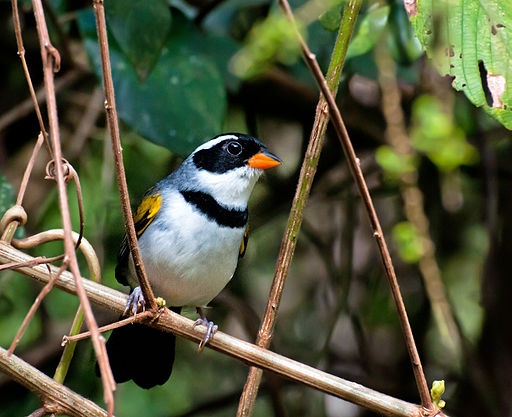Brazil, CC BY-SA 2.0 <https://creativecommons.org/licenses/by-sa/2.0>, via Wikimedia Commons" href="https://commons.wikimedia.org/wiki/File:Arremon_flavirostris_-Piraju,_Sao_Paulo,_Brazil-8.jpg">
Superregnum: Eukaryota
Cladus: Unikonta
Cladus: Opisthokonta
Cladus: Holozoa
Regnum: Animalia
Subregnum: Eumetazoa
Cladus: Bilateria
Cladus: Nephrozoa
Superphylum: Deuterostomia
Phylum: Chordata
Subphylum: Vertebrata
Infraphylum: Gnathostomata
Megaclassis: Osteichthyes
Cladus: Sarcopterygii
Cladus: Rhipidistia
Cladus: Tetrapodomorpha
Cladus: Eotetrapodiformes
Cladus: Elpistostegalia
Superclassis: Tetrapoda
Cladus: Reptiliomorpha
Cladus: Amniota
Classis: Reptilia
Cladus: Eureptilia
Cladus: Romeriida
Subclassis: Diapsida
Cladus: Sauria
Infraclassis: Archosauromorpha
Cladus: Crurotarsi
Divisio: Archosauria
Cladus: Avemetatarsalia
Cladus: Ornithodira
Subtaxon: Dinosauromorpha
Cladus: Dinosauriformes
Cladus: Dracohors
Cladus: Dinosauria
Ordo: Saurischia
Cladus: Eusaurischia
Cladus: Theropoda
Cladus: Neotheropoda
Cladus: Averostra
Cladus: Tetanurae
Cladus: Avetheropoda
Cladus: Coelurosauria
Cladus: Tyrannoraptora
Cladus: Maniraptoromorpha
Cladus: Maniraptoriformes
Cladus: Maniraptora
Cladus: Pennaraptora
Cladus: Paraves
Cladus: Eumaniraptora
Cladus: Avialae
Infraclassis: Aves
Cladus: Euavialae
Cladus: Avebrevicauda
Cladus: Pygostylia
Cladus: Ornithothoraces
Cladus: Ornithuromorpha
Cladus: Carinatae
Parvclassis: Neornithes
Cohors: Neognathae
Cladus: Neoaves
Cladus: Telluraves
Cladus: Australaves
Ordo: Passeriformes
Subordo: Passeri
Infraordo: Passerida
Superfamilia: Passeroidea
Familia: Passerellidae
Genus: Arremon
Species: Arremon schlegeli
Subspecies: A. s. canidorsum – A. s. fratruelis – A. s. schlegeli
Name
Arremon schlegeli Bonaparte, 1850
References
Bonaparte, C.L. 1850. Conspectus generum avium. Tome I. pp. [1–5], 1–543. Lugduni Batavorum (Leida). (E.J. Brill). p. 488 BHL Reference page.
Vernacular names
English: Golden-winged Sparrow
español: Cerquero alidorado
The golden-winged sparrow (Arremon schlegeli) is a species of bird in the family Passerellidae that can found in Colombia and Venezuela. Its natural habitats are subtropical or tropical dry forests and subtropical or tropical dry shrubland.
Subspecies and its distribution
So far, three subspecies of this bird have been recognized: A. s. schlegeli located along Caribbean costs of Colombia and Venezuela. A. s. fratruelis can be found in Serranía de Macuira, located on the Guajira Peninsula of northern Columbia. The other, A. s. canidorsum, can be found in the north Columbian Andes.[2]
References
BirdLife International (2016). "Arremon schlegeli". IUCN Red List of Threatened Species. 2016: e.T22721372A94709438. doi:10.2305/IUCN.UK.2016-3.RLTS.T22721372A94709438.en. Retrieved 12 November 2021.
Subspecies distribution
The saffron-billed sparrow (Arremon flavirostris) is a species of bird in the family Passerellidae, the New World sparrows. It is found in Argentina, Bolivia, Brazil, and Paraguay.[2]
Taxonomy and systematics
The saffron-billed sparrow has two subspecies, the nominate Arremon flavirostris flavirostris and the "gray-backed" A. f. polionotus.[3] In January 2021, both the South American Classification Committee (SACC) of the American Ornithological Society (AOS) and the International Ornithological Congress (IOC) elevated the former subspecies A. f. dorbignii to species status as the moss-backed sparrow.[4][2]
Description
The saffron-billed sparrow's name comes from its "striking orange bill". The adult male's head is mostly black, with a white supercilium from above the eye to the back of the head. The neck is gray and the back, wings, and tail are green. Its underside is white with grayish edges and a narrow black band across the upper chest. The adult female is similar but duller overall. The female's underparts are buffy with brown flanks. Juveniles are similar to the adults but duller. The species' length is from 15 to 16.5 cm (5.9 to 6.5 in). The mean weights of 27 specimens from three populations were from 23.6 to 28.1 g (0.83 to 0.99 oz).[3]
Distribution and habitat
The nominate subspecies of saffron-billed sparrow is found in central and eastern Brazil. The "gray-backed" subspecies is found further south, in central and southern Brazil, eastern Bolivia, much of Paraguay, and northeastern Argentina.[2][3]
The saffron-billed sparrow primarily inhabits tropical deciduous forest, both primary and second-growth. It is often found near forest edges, interior openings, and along waterways. In elevation it ranges from sea level to 1,400 m (4,600 ft).[3][1]
Behavior
Feeding
Though the saffron-billed sparrow's diet is not well known, it does include fruit, grain, and insects.[3]
Vocalization
The song of the saffron-billed sparrow is a series of rapid notes variously described as "tsit, tsee-tsi-tsi, tseép-seép-tseép" and "sidsidlidsidlsidli". Its call is an insect-like "tseet". It vocalizes on or near the ground.[3]
Status
The IUCN has assessed the saffron-billed sparrow as of Least Concern. Though the species' population has not been determined, it is believed to the stable. It inhabits a very large range and appears to tolerate forest fragmentation.[1][3]
References
BirdLife International (2019). "Arremon flavirostris". IUCN Red List of Threatened Species. 2019: e.T155185342A155636080. doi:10.2305/IUCN.UK.2019-3.RLTS.T155185342A155636080.en. Retrieved 15 November 2021.
Gill, F.; Donsker, D.; Rasmussen, P. (January 2021). "IOC World Bird List (v 11.1)". Retrieved January 14, 2021.
Gunningham, H. R. and D. L. Slager (2020). Saffron-billed Sparrow (Arremon flavirostris), version 1.0. In Birds of the World (T. S. Schulenberg, Editor). Cornell Lab of Ornithology, Ithaca, NY, USA. https://doi.org/10.2173/bow.sabspa1.01 retrieved April 25, 2021
Remsen, J. V., Jr., J. I. Areta, E. Bonaccorso, S. Claramunt, A. Jaramillo, D. F. Lane, J. F. Pacheco, M. B. Robbins, F. G. Stiles, and K. J. Zimmer. Version 19 January 2021. A classification of the bird species of South America. American Ornithological Society. http://www.museum.lsu.edu/~Remsen/SACCBaseline.htm retrieved January 19, 2021
Further reading
Auer, Sonya K.; Bassar, Ronald D.; Fontaine, Joseph J. & Martin, Thomas E. (2007): Breeding biology of passerines in a subtropical montane forest in Northwestern Argentina. The Condor 109(2): 321-333 [English with Spanish abstract]. DOI:10.1650/0010-5422(2007)109[321:BBOPIA]2.0.CO;2 PDF fulltext
Retrieved from "http://en.wikipedia.org/"
All text is available under the terms of the GNU Free Documentation License

